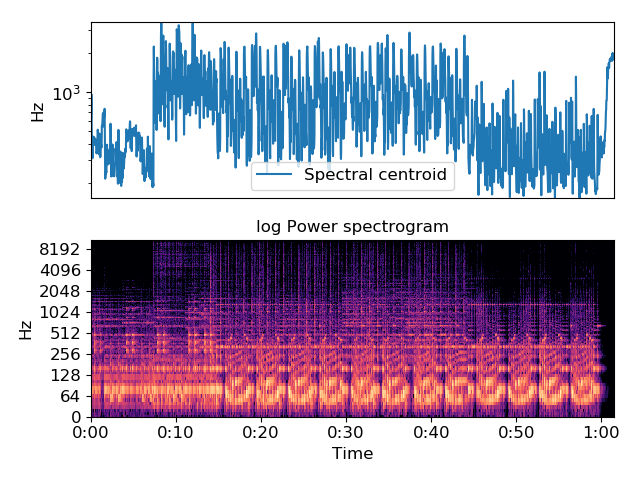librosa.feature.spectral_centroid¶
-
librosa.feature.spectral_centroid(y=None, sr=22050, S=None, n_fft=2048, hop_length=512, freq=None)[source]¶ Compute the spectral centroid.
Each frame of a magnitude spectrogram is normalized and treated as a distribution over frequency bins, from which the mean (centroid) is extracted per frame.
Parameters: - y : np.ndarray [shape=(n,)] or None
audio time series
- sr : number > 0 [scalar]
audio sampling rate of y
- S : np.ndarray [shape=(d, t)] or None
(optional) spectrogram magnitude
- n_fft : int > 0 [scalar]
FFT window size
- hop_length : int > 0 [scalar]
hop length for STFT. See
librosa.core.stftfor details.- freq : None or np.ndarray [shape=(d,) or shape=(d, t)]
Center frequencies for spectrogram bins. If None, then FFT bin center frequencies are used. Otherwise, it can be a single array of d center frequencies, or a matrix of center frequencies as constructed by
librosa.core.ifgram
Returns: - centroid : np.ndarray [shape=(1, t)]
centroid frequencies
See also
librosa.core.stft- Short-time Fourier Transform
librosa.core.ifgram- Instantaneous-frequency spectrogram
Examples
From time-series input:
>>> y, sr = librosa.load(librosa.util.example_audio_file()) >>> cent = librosa.feature.spectral_centroid(y=y, sr=sr) >>> cent array([[ 4382.894, 626.588, ..., 5037.07 , 5413.398]])
From spectrogram input:
>>> S, phase = librosa.magphase(librosa.stft(y=y)) >>> librosa.feature.spectral_centroid(S=S) array([[ 4382.894, 626.588, ..., 5037.07 , 5413.398]])
Using variable bin center frequencies:
>>> y, sr = librosa.load(librosa.util.example_audio_file()) >>> if_gram, D = librosa.ifgram(y) >>> librosa.feature.spectral_centroid(S=np.abs(D), freq=if_gram) array([[ 4420.719, 625.769, ..., 5011.86 , 5221.492]])
Plot the result
>>> import matplotlib.pyplot as plt >>> plt.figure() >>> plt.subplot(2, 1, 1) >>> plt.semilogy(cent.T, label='Spectral centroid') >>> plt.ylabel('Hz') >>> plt.xticks([]) >>> plt.xlim([0, cent.shape[-1]]) >>> plt.legend() >>> plt.subplot(2, 1, 2) >>> librosa.display.specshow(librosa.amplitude_to_db(S, ref=np.max), ... y_axis='log', x_axis='time') >>> plt.title('log Power spectrogram') >>> plt.tight_layout()
